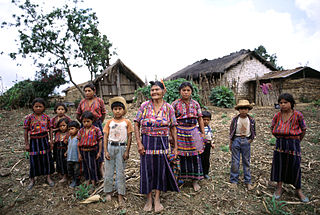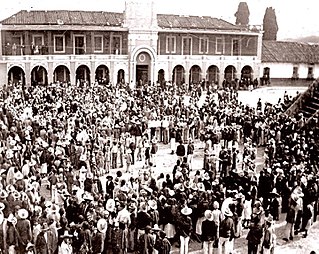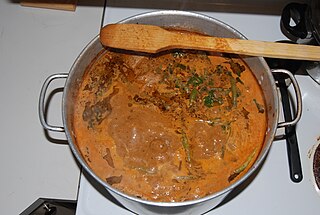Related Research Articles

This is a demography of the population of Guatemala including population density, ethnicity, education level, health of the populace, economic status, religious affiliations and other aspects of the population.

A tamale, in Spanish tamal, is a traditional Mesoamerican dish made of masa, a dough made from nixtamalized corn, which is steamed in a corn husk or banana leaves. The wrapping can either be discarded prior to eating or used as a plate. Tamales can be filled with meats, cheeses, fruits, vegetables, herbs, chilies, or any preparation according to taste, and both the filling and the cooking liquid may be seasoned.

The Mayan languages form a language family spoken in Mesoamerica, both in the south of Mexico and northern Central America. Mayan languages are spoken by at least six million Maya people, primarily in Guatemala, Mexico, Belize, El Salvador and Honduras. In 1996, Guatemala formally recognized 21 Mayan languages by name, and Mexico recognizes eight within its territory.
Kʼicheʼ are Indigenous peoples of the Americas and are one of the Maya peoples. The eponymous Kʼicheʼ language is a Mesoamerican language in the Mayan language family. The highland Kʼicheʼ states in the pre-Columbian era are associated with the ancient Maya civilization, and reached the peak of their power and influence during the Mayan Postclassic period.

The Maya are an ethnolinguistic group of indigenous peoples of Mesoamerica. The ancient Maya civilization was formed by members of this group, and today's Maya are generally descended from people who lived within that historical region. Today they inhabit southern Mexico, Guatemala, Belize, and westernmost El Salvador and Honduras.

Lake Atitlán is a lake in the Guatemalan Highlands of the Sierra Madre mountain range. The lake is located in the Sololá Department of southwestern Guatemala. It is known as the deepest lake in Central America.

The Kaqchikel are one of the indigenous Maya peoples of the midwestern highlands of Guatemala and of southern Mexico. They constitute Guatemala's third largest Maya group. The name was formerly spelled in various other ways, including Cakchiquel, Kakchiquel, Caqchikel, and Cachiquel.

In a protracted conflict during the Spanish colonization of the Americas, Spanish colonisers gradually incorporated the territory that became the modern country of Guatemala into the colonial Viceroyalty of New Spain. Before the conquest, this territory contained a number of competing Mesoamerican kingdoms, the majority of which were Maya. Many conquistadors viewed the Maya as "infidels" who needed to be forcefully converted and pacified, disregarding the achievements of their civilization. The first contact between the Maya and European explorers came in the early 16th century when a Spanish ship sailing from Panama to Santo Domingo was wrecked on the east coast of the Yucatán Peninsula in 1511. Several Spanish expeditions followed in 1517 and 1519, making landfall on various parts of the Yucatán coast. The Spanish conquest of the Maya was a prolonged affair; the Maya kingdoms resisted integration into the Spanish Empire with such tenacity that their defeat took almost two centuries.

Tecpán is a town, with a population of 34,519, and a municipality in the department of Chimaltenango, in Guatemala, on the Inter-American Highway CA-1.
The Kaqchikel language is an indigenous Mesoamerican language and a member of the Quichean–Mamean branch of the Mayan languages family. It is spoken by the indigenous Kaqchikel people in central Guatemala. It is closely related to the Kʼicheʼ (Quiché) and Tzʼutujil languages.

The Annals of the Cakchiquels is a manuscript written in Kaqchikel by Francisco Hernández Arana Xajilá in 1571, and completed by his grandson, Francisco Rojas, in 1604. The manuscript — which describes the legends of the Kaqchikel nation and has historical and mythological components — is considered an important historical document on post-classic Maya civilization in the highlands of Guatemala.

Iximcheʼ is a Pre-Columbian Mesoamerican archaeological site in the western highlands of Guatemala. Iximche was the capital of the Late Postclassic Kaqchikel Maya kingdom from 1470 until its abandonment in 1524. The architecture of the site included a number of pyramid-temples, palaces and two Mesoamerican ballcourts. Excavators uncovered the poorly preserved remains of painted murals on some of the buildings and ample evidence of human sacrifice. The ruins of Iximche were declared a Guatemalan National Monument in the 1960s. The site has a small museum displaying a number of pieces found there, including sculptures and ceramics. It is open daily.
The Academia de Lenguas Mayas de Guatemala, or ALMG is a Guatemalan organisation that regulates the use of the 22 Mayan languages spoken within the borders of the republic. It has expended particular efforts on standardising the various writing systems used. Another of its functions is to promote Mayan culture, which it does by providing courses in the country's various Mayan languages and by training Spanish-Mayan interpreters.

Most traditional foods in Guatemalan cuisine are based on Maya cuisine, with Spanish influence, and prominently feature corn, chilies and beans as key ingredients. Guatemala is famously home to the Hass avocado.

Nigerian cuisine consists of dishes or food items from the hundreds of Native African ethnic groups that comprises Nigeria. Like other West African cuisines, it uses spices and herbs with palm oil or groundnut oil to create deeply flavored sauces and soups.

Sundubu-jjigae (Korean: 순두부찌개) is a jjigae in Korean cuisine. The dish is made with freshly curdled extra soft tofu (sundubu) which has not been strained and pressed, vegetables, sometimes mushrooms, onion, optional seafood, optional meat, and gochujang or gochugaru. The dish is assembled and cooked directly in the serving vessel, which is traditionally made of thick, robust porcelain, but can also be ground out of solid stone. A raw egg can be put in the jjigae just before serving, and the dish is delivered while bubbling vigorously. It is typically eaten with a bowl of cooked white rice and several banchan.

The Kʼicheʼ kingdom of Qʼumarkaj was a state in the highlands of modern-day Guatemala which was founded by the Kʼicheʼ (Quiché) Maya in the thirteenth century, and which expanded through the fifteenth century until it was conquered by Spanish and Nahua forces led by Pedro de Alvarado in 1524.
Cauqué Mayan is a mixed language spoken in the aldea of Santa María Cauqué, Santiago Sacatepéquez, in the Department of Sacatepéquez in Guatemala. It is a Kʼicheʼ (Quiché) base relexified by Kaqchikel (Cakchiquel). During the colonial era, Kʼicheʼ migrated to Sacatepéquez, in the heart of Kaqchikel territory, where they founded the village of Santa María Cauque. Today only older adults retain the Kʼicheʼ base to their speech: for younger speakers, the language has merged into Kaqchikel.

Pascual Abaj, also known as Turcaj, Turk'aj, Turuk'aj and Turukaj, is a pre-Columbian Maya idol at Chichicastenango that survived the Spanish conquest of Guatemala and which is still venerated by the local community. It is the best-known example of such an image. The image was badly damaged in the 1950s by members of Catholic Action.

Pepián is a thick meat stew from Guatemala. It is one of the oldest and most recognizable dishes of Guatemalan cuisine having as its origin the influences from Guatemala's colonial past and the indigenous cuisine. The meat-based stew, thickened with gourd seeds, can be made with beef or chicken it includes in traditional recipes tomatillo, tomato and hot chili. Guatemalan restaurants in the United States usually consider the dish to be of Maya origin. It is a popular street food in Guatemalan cities.
References
- ↑ Doyle, Rachel B. (2015-04-08). "36 Hours in Antigua, Guatemala". The New York Times. ISSN 0362-4331 . Retrieved 2017-03-05.
- 1 2 Julia Ewan (Oct 8, 2008). "Subanik". The Washington Post . Retrieved Jun 6, 2015.
- ↑ "Suban- ik". Prensa Libre. Retrieved 2017-03-05.